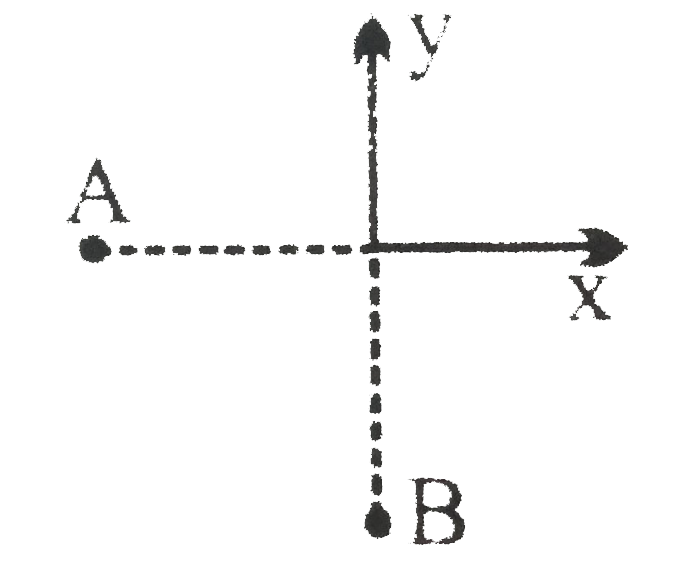Two particles A and B start moving with velocities 20 m/s and 30√2 m/s along x-axis and at an angle 45∘ with x- axis respectively in xy-plane from origin the relative velocity of B w.r.t A
(10ˆi+30ˆj) m/s
(30ˆi+10ˆj) m/s
(30ˆi−20√2ˆj) m/s
(30√2ˆi+10√2ˆj) m/s
The correct Answer is:A
To find the relative velocity of particle B with respect to particle A, we can follow these steps:
Step 1: Identify the velocities of particles A and B.
- Particle A is moving along the x-axis with a velocity of vA=20m/s.
- Particle B is moving at an angle of 45∘ with the x-axis with a velocity of vB=30√2m/s.
Step 2: Break down the velocity of particle B into its components.
- The x-component of the velocity of B can be calculated using:
vBx=vB⋅cos(45∘)=30√2⋅1√2=30m/s
- The y-component of the velocity of B can be calculated using:
vBy=vB⋅sin(45∘)=30√2⋅1√2=30m/s
Step 3: Write the velocity vectors of particles A and B.
- The velocity vector of A is:
→vA=20^i
- The velocity vector of B is:
→vB=30^i+30^j
Step 4: Calculate the relative velocity of B with respect to A.
- The relative velocity of B with respect to A is given by:
→vBA=→vB−→vA
- Substituting the values:
→vBA=(30^i+30^j)−(20^i)=(30−20)^i+30^j=10^i+30^j
Step 5: State the final result.
- The relative velocity of particle B with respect to particle A is:
→vBA=10^i+30^jm/s
- Particle A is moving along the x-axis with a velocity of vA=20m/s.
- Particle B is moving at an angle of 45∘ with the x-axis with a velocity of vB=30√2m/s.
- The x-component of the velocity of B can be calculated using:
vBx=vB⋅cos(45∘)=30√2⋅1√2=30m/s
- The y-component of the velocity of B can be calculated using:
vBy=vB⋅sin(45∘)=30√2⋅1√2=30m/s
- The velocity vector of A is:
→vA=20^i
- The velocity vector of B is:
→vB=30^i+30^j
- The relative velocity of B with respect to A is given by:
→vBA=→vB−→vA
- Substituting the values:
→vBA=(30^i+30^j)−(20^i)=(30−20)^i+30^j=10^i+30^j
- The relative velocity of particle B with respect to particle A is:
→vBA=10^i+30^jm/s
Similar Questions
Two particles A and B moving in a plane have velocities as shown in figure .Relative velocity of A w.r.t B
View SolutionA car A moves with velocity 15ms−1 and B with velocity 20ms−1 are moving in opposite directions as shown in . Find the relative velocity of B w.r.t. A and w.r.t. B.
 .
.
View SolutionTwo particles P and Q simultaneously start moving from point A with velocities 15m/s and 20m/s respectively. The two particles move with acceleration equal in magnitude but opposite in direction. When P overtakes Q at point B then its velocity is 30m/s, the velocity of Q at point B will be
View SolutionA and B are moving with the same speed 10m/s in the direction E−30∘−N and E−30∘−S respectively. Find the relative velocity of A w.r.t. B.
View Solutionf A and B persons are moving with VAandVB. velocities in opposite directions. Magnitude of relative velocity of B w.r.t. A is x and magni-tude of relative velocity of A w.r.t B is y. Then
View SolutionBuses A and B are moving in the same direction with speed 20ms−1 and 15ms−1 respectively. Find the relative velcoity of A w.r.t. B and relative velocity of B w.r.t. A.
View SolutionParticles A and B are moving with constant velocities along x and y axis respectively, the graph of separation between them with time is

View SolutionA man 'A' moves in north direction with speed 10m/s and another man B moves in E−30∘−N with 10m/s. Find the relative velocity of B w.r.t. A.
View SolutionTwo objects A and B are moving in opposite directions with velocities vAandvB respectively, the magnitude of relative velocity of A w.r.t. B is
View SolutionA particle is projected from ground with velocity 40√2m/s at 45∘. At time t=2s
View Solution
